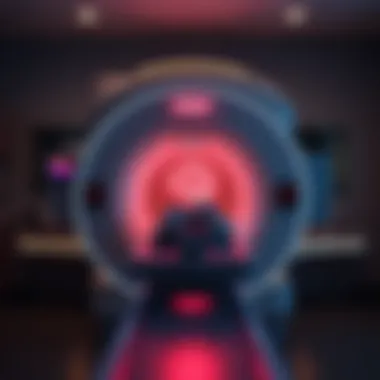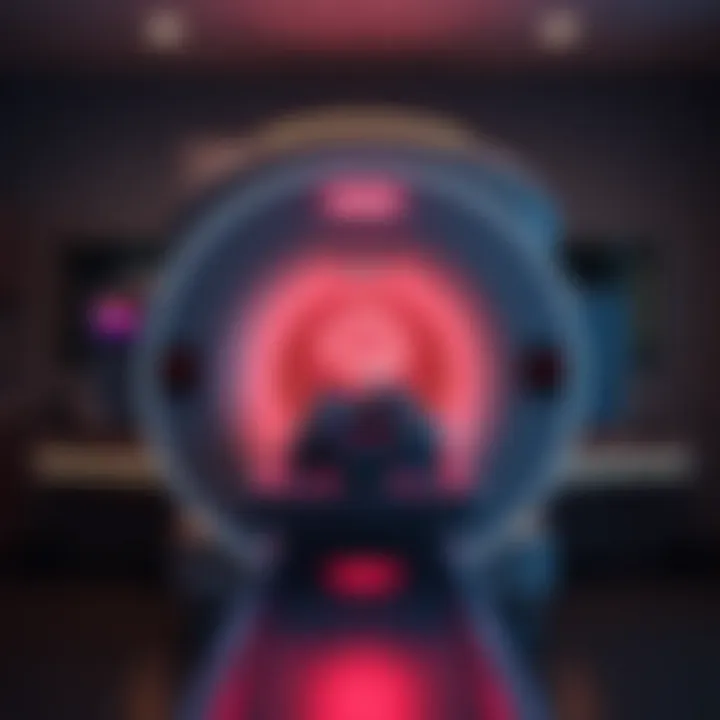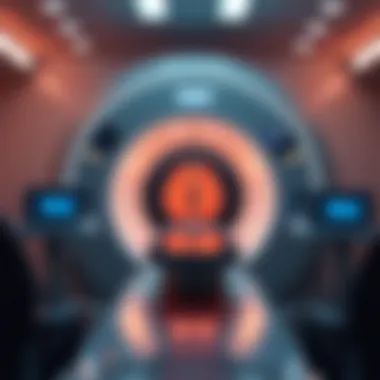Boston Scientific Deep Brain Stimulator MRI Safety Overview


Intro
In a world where technology rapidly evolves, the intersection of medical devices and imaging techniques raises both promising potentials and daunting challenges. One such intersection is where Boston Scientific's deep brain stimulators meet magnetic resonance imaging (MRI). These devices have become essential in treating various neurological disorders by delivering electrical impulses to specific brain areas. Yet, when patients with these stimulators enter an MRI machine, safety becomes a paramount concern.
Understanding the safety protocols and considerations surrounding the use of deep brain stimulators during MRI procedures is crucial for healthcare professionals and patients alike. With various studies shedding light on the potential risks, including heating and movement of device components during scans, clinicians must navigate these complexities effectively for optimal patient care.
As we delve into this topic, we will outline the critical safety measures established by Boston Scientific. By synthesizing clinical research and expert opinions, we aim to guide stakeholders through the essential knowledge necessary for making informed decisions in a clinical environment. Keeping abreast of best practices not only aids in risk mitigation but also enhances the overall treatment experience for patients with neurological conditions.
Understanding Deep Brain Stimulation
Deep Brain Stimulation (DBS) has emerged as a revolutionary approach in the treatment of neurological disorders, particularly for patients experiencing conditions like Parkinson’s disease, essential tremor, and dystonia. Understanding the mechanisms and history of DBS is crucial, as it provides context for the discussions on MRI safety and protocols unique to Boston Scientific's devices. The significance of this topic can't be overstated; it sheds light on both the therapy's efficacy and associated challenges, especially when it comes to imaging techniques like MRI.
Traditionally, patients with movement disorders have faced limitations in managing their symptoms. Deep brain stimulation offers a beacon of hope, acting almost like a pacemaker for the brain. This treatment involves implanting a device that sends electrical impulses to specific brain regions, effectively modulating neural activity. The positive outcomes from DBS therapy extend beyond symptom relief; they also improve quality of life, allowing many patients to regain autonomy in daily tasks.
However, with these advancements come important considerations. Notably, the interaction between DBS devices and MRI technology raises questions regarding patient safety. As MRI plays a vital role in diagnosing and monitoring neurological conditions, understanding how to safely integrate both methods is imperative.
In summary, grasping the nuances of deep brain stimulation presents both an opportunity and a responsibility for healthcare professionals. It allows them to provide insightful counseling to patients regarding their treatment options and the implications of undergoing subsequent imaging procedures. With this foundation in place, we can now explore the historical context that has shaped DBS as we know it today.
Historical Context of Deep Brain Stimulation
The journey of deep brain stimulation is as rich as it is complex. Its origins can be traced back to the 1940s and 50s when neurosurgeons delved into the depths of the brain to explore its intricate networks. Early interventions were primarily focused on lesioning specific regions of the brain, which, while sometimes effective, were not without risks and permanent side effects.
The pivotal turn came in the late 20th century with the advent of DBS. The inaugural procedures were performed in the 1980s by pioneering surgeons who discovered that electrically stimulating certain brain areas could alleviate severe symptoms without permanent damage. This was a major breakthrough in the field.
As the technology advanced over the decades, not only did the implants become more refined in design—minimizing size and maximizing biocompatibility—but also the understanding of brain circuitry evolved significantly. Today, DBS is a standard practice for many refractory movement disorders, improving lives worldwide.
Mechanism of Action
At its core, deep brain stimulation is all about restoring balance in the brain's intricate communication pathways. The brain utilizes electrical signals to transmit information, and when these signals are disrupted, it can lead to motor dysfunctions. DBS works by delivering targeted electrical pulses from implanted electrodes to specific brain regions.
This modulation helps to normalize the abnormal signals that lead to symptoms of various movement disorders. For instance, in patients with Parkinson’s disease, DBS can effectively reduce tremors, rigidity, and bradykinesia. The application of stimulation is highly customizable, allowing clinicians to adjust parameters based on individual patient responses.
Importantly, understanding how these devices interact with various imaging modalities, particularly MRI, is pivotal since patients often require imaging for ongoing assessment of their conditions.
Common Indications for Use
Deep brain stimulation is primarily indicated for several debilitating conditions:
- Parkinson's Disease: For many patients who do not respond optimally to medication, DBS can significantly alleviate symptoms.
- Essential Tremor: This condition, marked by involuntary shaking, can be effectively managed through targeted stimulation.
- Dystonia: DBS has shown promise in treating various forms of dystonia, providing relief in muscle contractions.
- Obsessive-Compulsive Disorder (OCD): Although still considered an evolving application, DBS is being explored as an option for treatment-resistant OCD.
The existence of these varied indications emphasizes the versatility of DBS as a therapeutic modality.
Prelude to Boston Scientific's Deep Brain Stimulators
When thinking about deep brain stimulation (DBS) today, Boston Scientific often comes to the forefront of discussions within the medical community. The company's line of deep brain stimulators is not merely a collection of devices but represents a synthesis of technological advancement and clinical application. Understanding these stimulators lays the groundwork for addressing their safety, particularly in the realm of MRI procedures.
What Boston Scientific offers is a varied product range, each designed to cater to specific patient needs while also considering the unique challenges posed by the MRI environment. This is critical when you consider that MRI technology frequently plays a vital role in assessing brain health.
Overview of Product Range
Boston Scientific manufactures several deep brain stimulators that stand out due to their versatility and adaptability. Each product in their lineup includes features engineered to meet unique therapeutic needs. For instance, the Infinity DBS System, with its advanced steering technology, allows for greater customization of stimulation patterns. This is especially useful for conditions like Parkinson's disease and essential tremor, where personalized treatment is crucial.
In contrast, the Versa DBS System serves as an alternative that emphasizes simplicity and ease of use. By having a streamlined design and patient-friendly features, it focuses on providing effective stimulation while minimizing complexity. The array of devices available ensures that healthcare professionals can find a fitting match for their patients, which is vital for improving long-term outcomes.
The diversity in product offerings not only highlights the company’s commitment to enhancing patient care but also underscores the overarching goal of achieving significant improvements in quality of life. As we delve deeper into these stimulators, we will note their critical role in ensuring safety during MRI scans, which is essential for the ongoing care and advancement of treatment options in neuromodulation.
Technological Innovations
Boston Scientific’s approach to innovation is a deliberate interplay between established methodologies and cutting-edge technology. Their deep brain stimulators integrate several advancements designed to optimize therapeutic outcomes.
One key innovation is the use of adaptive stimulation which adjusts the therapy automatically based on real-time feedback from the brain. This responsiveness can mean the difference between adequate control of symptoms and optimal relief for patients.
Moreover, there’s the clinical dashboard, which provides clinicians with valuable data and insights into the patients’ response to stimulation. Such features reinforce the notion of data-driven decisions in managing those with movement disorders or other applicable conditions.
With each stride in technology, however, comes the pressing need to understand the implications of these advancements in the context of MRI safety. It’s paramount for both providers and patients to appreciate how these innovations could affect procedures involving MRI while using deep brain stimulators.
MRI Technology: Basics and Applications


MRI technology represents a cornerstone in medical imaging, unlocking a treasure trove of insights into the human body without the use of radiation. This section delves deep into both the fundamentals of Magnetic Resonance Imaging and its applications, particularly focusing on the implications for patients with deep brain stimulators such as those produced by Boston Scientific.
Fundamentals of MRI
Understanding how MRI works begins at the atomic level. MRI leverages the properties of hydrogen atoms in our bodies, primarily found in water, to create detailed images. When placed in a magnetic field, these atoms align in accordance with the field. A sequence of radiofrequency pulses is then utilized, nudging the atoms away from equilibrium. As they return to their original positions, they emit signals that are collected to create an image.
Some key elements that contribute to the value of MRI technology include:
- Non-invasiveness: MRI does not require any incisions or injections, making it a favorite among both patients and clinicians.
- High-resolution images: It produces exceptionally detailed images of organs and tissues, aiding in detecting abnormalities effectively.
- Versatility: MRI can be adapted for various needs, from brain scans to joint imaging, making it an indispensable diagnostic tool.
It's worth noting that while MRI is safe, the presence of implanted devices like deep brain stimulators can influence both the procedure and outcomes, emphasizing the need for clear safety protocols.
MRI in Neuroscience Research
MRI's role in neuroscience research extends far beyond typical diagnostics. Its ability to visualize brain structure and function in real-time makes it an invaluable tool for researchers. Some significant contributions of MRI technology in this field include:
- Mapping brain activity: Functional MRI (fMRI) tracks blood flow changes in the brain, which correlate with neuronal activity. This ability to observe real-time brain function has propelled our understanding of cognitive processes, emotional regulation, and much more.
- Studying neurological disorders: MRI has been pivotal in examining conditions such as Parkinson’s disease, Alzheimer’s, and multiple sclerosis. Researchers can visualize the progression of these diseases and assess the impact of therapeutic interventions.
- Lead in clinical trials: MRI serves as a non-invasive method to evaluate new treatments, track disease progression, and measure treatment effectiveness.
Critical Insight: “Thorough understanding of MRI technology is crucial for both clinicians and researchers, especially when it comes to ensuring patient safety during MRI procedures with deep brain stimulators.”
In summary, MRI technology's fundamental and innovative applications provide crucial insights into the functioning of the human body, especially in the realm of neuroscience. The dialogue doesn’t end with producing images; understanding how to integrate and adapt this technology for patients with deep brain stimulators adds another layer of responsibility and care in clinical practice.
Safety Considerations for MRI in Patients with Deep Brain Stimulators
Deep brain stimulation (DBS) is often a game changer for those battling neurological conditions, presenting immense opportunities for relief and improved quality of life. However, when it comes to imaging, especially magnetic resonance imaging (MRI), there’s a labyrinthine world of considerations to sift through. Understanding the safety considerations for patients with Boston Scientific’s deep brain stimulators is not just essential; it’s critical.
The relationship between DBS devices and MRI technology can be an intricate dance of balance where the stakes are high. As healthcare providers and patients navigate the complexities, grasping these safety considerations becomes paramount. It’s not merely about getting a picture; it’s about ensuring that the underlying technology supports rather than sabotages the patient’s health and wellbeing. MRI is widely recognized for its diagnostic capabilities, yet its interaction with DBS systems can introduce risks and complications that warrant thorough exploration.
Electromagnetic Interference
Electromagnetic interference (EMI) is often the uninvited guest at the MRI party. For patients equipped with deep brain stimulators, the strong magnetic fields produced by MRI machines can create interference that may impact the DBS device's functionality. Essentially, the turning off or altering the programming of the stimulator can jeopardize its therapeutic effects. Much needs to be done to ensure that both safety and diagnostic needs are perfectly in sync.
During an MRI, high-powered magnets generate electromagnetic fields that can cause the implanted DBS device to malfunction or lead to unintended side effects.
In essence, while MRI can unlock a wealth of vital information, it can also potentially jeopardize the very tools we depend on for management of serious conditions.
Thus, clinicians often conduct pre-MRI evaluations and screenings to gauge how the specific device responds to electromagnetic fields. Such discussions help craft the most tailored and safe imaging plans possible.
Potential Risks Involved
The potential risks involved with performing MRI scans on individuals with deep brain stimulators involve several dimensions—from physical to physiological concerns.
1. Device Displacement: In some cases, high magnetic forces may lead to the movement of the electrode or the pulse generator. This can potentially cause discomfort or necessitate revision surgery. Understanding the device’s anchoring mechanisms and how they are affected by MRI is essential for patient safety.
2. Heating Effects: Another serious concern is the heating of the leads during MRI. The proximity of the leads to the MRI coils can generate heat, leading to burns or discomfort. This phenomenon warrants rigorous monitoring during the scan to ensure nothing goes awry.
3. Neurological Symptoms: Some patients might experience heightened symptoms or even new neurological issues post-MRI due to device malfunctioning or interference. For instance, the therapy may abruptly shift, causing involuntary movements or altered sensory perceptions. Medical professionals must remain vigilant, keeping a close eye on any changes.
Taking all these potential risks into account, planning for MRI scans involves stringent protocols, specifically tailored pathways to protect the patient's health while still accessing essential diagnostic imaging.
In closing, as technology evolves, so too must our understanding of its implications. Safety protocols and considerations specific to patients with deep brain stimulators in relation to MRI need to be ever-present in the minds of medical professionals, ensuring that this technology serves its purpose without undue risk.
Protocol Development for MRI Procedures
When delving into the complex interplay between deep brain stimulators and MRI technology, the significance of well-defined protocols cannot be overstated. Establishing a systematic approach to MRI procedures for patients with Boston Scientific’s deep brain stimulators is essential. This encompasses a multitude of dimensions including safety, patient comfort, and optimal imaging outcomes.
First and foremost, protocol development ensures safety. Safety protocols act as the cornerstone of MRI procedures, especially for those fitted with advanced devices like deep brain stimulators. These protocols are designed to minimize risks inherent to magnetic resonance imaging while ensuring that the needed diagnostic information can still be obtained. A thorough understanding of the functioning of Boston Scientific's deep brain stimulators is key to crafting guidelines that can effectively mitigate any potential complications.
Moreover, detailed pre-MRI and post-procedure considerations are a critical component of protocol development. The following elements are crucial in this development:
- Patient Screening: Proper screening prior to the MRI process is vital. This helps identify any contraindications that might arise due to the presence of the implant.
- Equipment Compatibility: Identifying specific MRI models that can safely perform scans on patients with deep brain stimulators is an involved process requiring detailed knowledge.
- Emergency Protocols: Establishing clear protocols for responding to adverse events during the MRI can be lifesaving.
- Patient Communication: Clear communication about the MRI process, risks, and required preparations—such as ensuring all metal objects are removed—is paramount for patient compliance.
Through the establishment of these comprehensive protocols, healthcare providers can significantly enhance both patient safety and the diagnostic efficacy of MRI scans in the context of deep brain stimulation. These efforts foster a collaborative environment where health professionals and patients alike can be well-informed and feel secure undergoing necessary imaging procedures.
Pre-MRI Screening Guidelines
The pre-MRI screening phase serves as a protective sieve, filtering out potential hazards associated with MRI scans in patients who have received deep brain stimulation devices manufactured by Boston Scientific. Each patient's medical history should be meticulously evaluated to ensure that no stone is left unturned. Here are key considerations for screening:
- Device Identification: Confirming the model of the implanted device. Each model may have unique compatibilities or contraindications when it comes to MRI exposure.
- Medical History Assessment: A comprehensive review of the patient’s previous medical history can unearth any risks associated with the MRI. This includes prior adverse reactions to MRIs or specific medical conditions.
- Consultation with Manufacturers: It’s prudent to consult Boston Scientific's guidelines to understand specific recommendations for their devices in relation to MRI protocols.


By following these guidelines, healthcare providers can mitigate risks and contribute to improving overall patient outcomes in MRI settings.
Post-Procedure Monitoring
Once the MRI is concluded, the focus immediately shifts to post-procedure monitoring, which is a critical aspect of safety protocols. Monitoring after MRI scans is especially crucial for individuals with deep brain stimulators, as unexpected complications can surface after the imaging session.
During this phase, healthcare professionals should consider the following:
- Observation for Adverse Effects: After the MRI, patients should be monitored for unusual symptoms such as headaches, dizziness, or changes in cognitive function, which may signal device-related issues due to magnetic exposure.
- Follow-Up Imaging: Depending on the results of the MRI, additional imaging might be necessary, necessitating further consultation with the patient to explain the next steps.
- Patient Education on Symptoms: Educating patients about the signs that warrant immediate medical attention can ensure rapid response to any complications.
Boston Scientific's Guidelines on MRI Safety
Navigating the complex landscape of MRI procedures in patients with deep brain stimulators is of utmost importance. Boston Scientific’s guidelines on MRI safety serve as a cornerstone for healthcare providers and patients alike, ensuring that both parties understand the implications of MRI procedures when deep brain stimulators are involved. These guidelines not only cover the technical aspects of the devices but also stress the nuances of patient care, thus fostering a collaborative approach to healthcare.
Manufacturer Recommendations
Boston Scientific has laid down specific recommendations aimed at enhancing patient safety during MRI scanning. For instance, when patients with deep brain stimulators need an MRI, the company prescribes several pre-scan protocols. Here are key takeaways:
- Device-specific Considerations: It's imperative for healthcare professionals to confirm that the deep brain stimulator model in use is MRI conditional. This means that the device has been tested under specific conditions and is safe for MRI under those defined circumstances.
- Scanning Parameters: The guidelines detail the most suitable scanning parameters to minimize risks. Generally, lower field strengths are recommended, and specific sequences that might induce high heating around the implanted device are discouraged.
- Magnetic Field Orientation: Boston Scientific outlines the importance of aligning the patient correctly in relation to the MRI magnet. Specific configurations can greatly reduce risks associated with electromagnetic interference.
Adhering to these manufacturer recommendations ensures that patients receive the safest possible MRI experience while minimizing complications related to deep brain stimulation devices.
Clinical Best Practices
In addition to manufacturer recommendations, it’s equally essential for practitioners to adopt clinical best practices for patient management during MRI procedures. Here are several best practices:
- Comprehensive Patient Screening: Before any MRI scan is performed, a detailed screening process should be in place. This involves checking the patient’s medical history, specifically looking for any contraindications related to the implanted device.
- Education and Informed Consent: Patients must be thoroughly informed about the risks associated with their specific type of deep brain stimulator and the MRI process. Having a well-synchronized conversation can alleviate anxiety and improve compliance with safety protocols.
- Post-Scan Follow-up: After the MRI, patients should be monitored for potential complications, such as device malfunction or changes in their neurological status. Regular follow-up ensures that any unexpected outcomes can be promptly addressed.
Patient Experience and Informed Consent
Patient experience and informed consent are not simply procedural steps in the clinical landscape; they are cornerstones of ethical medical practice, particularly when it pertains to advanced procedures such as deep brain stimulation (DBS). Drawing a direct line between patient comfort and informed decision-making can be particularly crucial in contexts where technology intertwines with neurological health. Understanding this relationship can enhance clinical outcomes and foster a therapeutic relationship between patients and healthcare providers.
When patients come in to discuss DBS, they often carry emotional and psychological burdens regarding their conditions, alongside questions about operational risks, functionality, and the implications of MRI scans post-implantation. A proactive approach to patient experience seeks to alleviate these anxieties by ensuring clarity around these facets.
The benefits of prioritizing informed consent in this setting include:
- Empowered Decision-Making: Patients who fully grasp their treatment options are enabled to make better choices that align with their values and lifestyle preferences.
- Reduced Anxiety: Clear communication about risks and benefits can help mitigate fears surrounding the procedure, making the whole process feel less daunting.
- Compliance and Follow-Up: A thorough discussion diminishes misunderstandings about post-operative care, leading to higher compliance rates during follow-ups.
While these may seem standard, it is critical that the communication process is not merely a cursory formality but instead a rich, informative dialogue. Each point of discussion opens a window for patients to voice their concerns and ask pertinent questions.
Communicating Risks to Patients
Communicating risks to patients with deep brain stimulators is an essential step that requires careful attention and skill. It is vital for healthcare professionals to outline not only the potential benefits of the procedure but also the risks specific to MRI scans.
"An informed patient is a partner in the medical process, not a mere subject."
This principle implies that healthcare practitioners should be open and transparent.
When conveying risks, the following strategies can enhance understanding:
- Clarity: Medical jargon can often muddy the waters. Using simple language helps bridge the knowledge gap.
- Visual Aids: Diagrams or illustrations showing the components, their placements, and the risks involved during MRI can facilitate understanding.
- Scenario Examples: Discussing real-life scenarios can offer tangible context. For example, explaining incidents or outcomes from previous patients can elucidate the potential variance in experiences.
Additionally, it's prudent to share tailored information. For instance, if a patient has specific concerns about certain behaviors during or after an MRI, addressing those directly can create a meaningful dialogue. Such exchanges ensure that patients feel seen and heard.
Ensuring Understanding and Compliance
Ensuring that patients not only understand the risks but also comply with safety protocols is integral to the MRI process for those with deep brain stimulators. Every piece of information provided must translate into tangible action on the patient’s part.
There are several critical aspects to consider for fostering compliance:
- Repetition of Key Information: Information may need to be repeated multiple times, in various formats, to cement understanding. Repetition can help in embedding vital safety protocols in the minds of patients.
- Follow-Up Conversations: Scheduling follow-up discussions can help clarify any lingering uncertainties that may arise after initial consultations.
- Teaching Moments: Incorporating role-playing or simulation can empower patients to demonstrate their understanding.
Healthcare professionals must take the time to verify exactly what a patient has understood. Quite often, a simple question like, "Can you explain back to me what you will do before the MRI?" can confirm the patient's grasp of their responsibilities in relation to their healthcare.
In summary, prioritizing patient experience through informed consent in relation to MRI safety and deep brain stimulators is not just a regulatory checklist but a fundamental aspect of ethical medical practice. Fostering a culture of openness, wherein patients feel challenged to engage with and understand their treatment options, ultimately leads to better healthcare outcomes and mutual trust.
Case Studies: MRI Safety in Clinical Practice
In the complex realm of healthcare, understanding how deep brain stimulators (DBS) interact with MRI technology is crucial. The significance of case studies lies not only in the data they present but in the practical insights they offer to clinicians, patients, and researchers. By examining real-world examples, we can assess the safety and efficacy of MRI scans for patients implanted with Boston Scientific's DBS systems and draw meaningful conclusions that can inform best practices.


Successful MRI Scans with Deep Brain Stimulation
Several case studies highlight successful MRI scans conducted on patients with DBS devices. One such example involves a 55-year-old man suffering from Parkinson's disease. After undergoing the placement of a Boston Scientific stimulator, his medical team decided an MRI was necessary to evaluate unrelated neurological symptoms.
The MRI was performed with special protocols adhered to, including ensuring that the MRI scanner was compatible with the device and adjusting scanning parameters to be within safe limits. Notably, reports indicated that the patient experienced no adverse effects during or after the MRI scan. Such successful outcomes showcase not only the compatibility of these stimulators with MRI technology but also the importance of strict adherence to safety protocols.
- Benefits:
- Understanding the technical compatibility can lead to better patient outcomes.
- Real-world success instills confidence among healthcare providers.
In addition, another striking instance involved a 64-year-old woman, where her neurosurgeon collaborated with radiologists to draft guidelines for her MRI scan. This proactive approach prevented potential complications and highlighted the essential collaboration across medical specialties. The scan's clear images provided critical information that guided her treatment journey.
Reported Complications and Lessons Learned
While some case studies demonstrate success, others provide a stark reminder of potential complications that can arise. One such case reported the experience of a patient who underwent an MRI shortly after the implantation of a DBS device. Unfortunately, the patient experienced significant discomfort during the procedure, attributed to electromagnetic interference with the stimulator. This incident raised crucial questions about timing, monitoring, and operational protocols.
- Key Lessons Learned:
- Staged imaging procedures may be necessary to minimize risks.
- Comprehensive understanding of device specifications is essential for healthcare providers.
The importance of pre-MRI screening guidelines becomes evident as complications surface. In another example, patients with mood disorders reported increased anxiety during MRI scans, leading to suboptimal imaging results. These experiences emphasize the significance of patient education and informed consent. The prospect of complications can induce distress, even if the risks are low. Thus, equipping patients with knowledge about what to expect can enhance their overall experience and promote adherence to follow-up protocols.
"Case studies serve as a bridge between theoretical knowledge and practical application, shedding light on the nuances of DBS and MRI interactions."
Future Directions in MRI and Deep Brain Stimulation
Understanding the future directions in MRI and deep brain stimulation (DBS) is crucial for multiple reasons. As technology evolves, so do the methods we use to diagnose and treat neurological disorders. The aim here is to dive into some of the advances being made in both the stimulation technologies and MRI techniques that will shape the future of treatment for patients.
Advancements in Stimulation Technology
Recent advancements in deep brain stimulation technology are opening up new avenues for treatment and improving the overall efficacy of therapies. Boston Scientific is at the forefront of these developments, with innovation driving better patient outcomes and less invasive procedures.
Key advancements include:
- Adaptive Stimulation Technologies: These are designed to automatically adjust stimulation parameters based on real-time feedback from the patient’s neurological state. This could lead to more tailored approaches in treating conditions, making the therapy more effective.
- Miniaturization of Devices: Advances in hardware have allowed for smaller, more discreet devices. These not only enhance comfort for the patient but can also lead to less invasive surgical procedures during installation.
- Integrated Data Systems: The ability to collect and analyze data on patient response to stimulation enhances our understanding of DBS. Such integration fosters a more personalized treatment approach, tailored to individual patient's needs.
These innovations not only improve the experience for patients but also provide health professionals with enhanced tools to manage neurological conditions effectively. As these technologies advance, they will likely reduce complications associated with MRI scanning, specifically related to the presence of implanted devices.
Evolving MRI Techniques
Alongside advancements in stimulation technology, the field of MRI is experiencing significant transformations. Evolving MRI techniques promise to enhance the safety and effectiveness of imaging patients with deep brain stimulators.
Emerging MRI techniques include:
- Ultra-High Field MRI: This technique provides better spatial resolution, enabling clearer imaging of brain structures and stimulation effects. Such clarity can significantly improve diagnostic accuracy, leading to more informed decisions regarding patient care.
- Diffusion Tensor Imaging (DTI): DTI is valuable in understanding the connectivity in neuronal pathways, lending insight into how DBS may influence brain circuitry. By understanding these networks better, medical professionals can tailor treatment plans more effectively.
- Functional MRI (fMRI): This technique looks at brain activity by detecting changes associated with blood flow. The integration of fMRI with DBS could open new doors in understanding how stimulation affects brain function dynamically.
With the combination of these advancements in both DBS and MRI technologies, the future appears promising. As the integration of these systems becomes more seamless, healthcare professionals can expect safer procedures and improved diagnostic capabilities.
In summary, as both DBS technology and MRI techniques continue to evolve, they hold the potential for a revolution in treatment approaches for neurological disorders, making the management of these conditions more precise and patient-centered.
As we think about what lies ahead, considerations about how these new technologies will be implemented in clinical practice must also take center stage. Continuous collaboration between engineers, neuroscientists, and clinicians will be paramount in realizing the full potential of these advancements.
Finale and Implications for Clinical Practice
In the context of the ever-evolving landscape of neuromodulation and imaging technologies, understanding the intersection of Boston Scientific's deep brain stimulators and MRI safety emerges as a crucial aspect of clinical practice. This knowledge not only enhances the quality of patient care but also informs healthcare professionals about the necessary protocols and safety measures that must be followed. By paying attention to how these stimulators interact with MRI environments, practitioners can effectively mitigate risks and maximize the benefits of these advanced therapeutic tools.
The summary of findings from this article underscores several key points:
- Interoperability: The compatibility of Boston Scientific's deep brain stimulators with MRI offers remarkable opportunities for comprehensive patient evaluation.
- Safety Protocols: Strict adherence to manufacturer guidelines and safety protocols is essential to prevent adverse events during MR imaging.
- Patient Education: Clear communication regarding the risks and benefits of MRI procedures for individuals with deep brain stimulators fosters informed consent and enhances patient safety.
- Future Directions: Continuous advancements in both MRI technology and deep brain stimulation techniques herald a promising future where patient outcomes can be further improved.
Understanding these aspects is not just a matter of protocol compliance; it can significantly influence treatment outcomes and patient satisfaction. Clinicians equipped with knowledge about MRI safety concerning deep brain stimulation can anticipate challenges and take proactive measures. This vigilance leads to improved clinical decisions that prioritize the well-being of patients while also enhancing the capabilities of imaging modalities.
Summarizing Key Points
To recap the essential takeaways:
- The integration of deep brain stimulation technology with MRI presents both opportunities and challenges.
- Adhering to established safety guidelines and protocols is vitally important.
- Engaging patients in decision-making processes improves compliance and understanding of their treatment journey.
- Ongoing research and technological developments will likely continue to refine MRI protocols for patients with stimulators.
These points serve as a reminder that the complexity of biomedical advancements requires a concerted effort from the entire healthcare team.
Recommendations for Healthcare Professionals
Healthcare professionals play a critical role in navigating the challenges associated with MRI safety in patients with deep brain stimulators. Here are some tailored recommendations to enhance clinical practice:
- Stay Informed: Regularly update your knowledge on the latest guidelines from Boston Scientific and other regulatory bodies regarding MRI protocols and safety measures.
- Educate Patients: Provide comprehensive information about the procedure, including what to expect before, during, and after the MRI scan. Make sure to address any concerns they may have about their deep brain stimulator.
- Collaborate with Radiologists: Establish clear lines of communication with radiologists who perform MRI scans on patients with stimulators to ensure everyone is on the same page regarding safety protocols.
- Use a Standardized Protocol: Create a protocol checklist for pre-scan assessments and post-scan monitoring. This checklist helps to streamline processes and ensures nothing is overlooked.
- Monitor Outcomes: Keep track of patient outcomes and any complications that arise during MRI procedures. This data can be invaluable for refining practices and improving safety.
By implementing these strategies, healthcare professionals can help create a safer environment for patients undergoing MRI scans with deep brain stimulation devices, ultimately advancing the field of neuromodulation.







